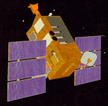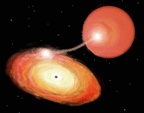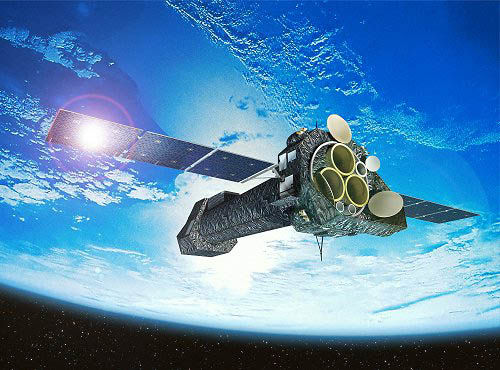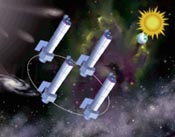Greater Collecting Area
Astronomers are in a constant search for light. The more light
an astronomer collects, the easier it is to determine the properties
of an object and to discover new phenomena.
In high-energy astronomy, astronomers gather light by counting
photons, which are particles of light. The limit to our knowledge
about the size, energy, or mass of an object depends
on how certain we are of the number of photons collected. The
relative uncertainty in the number of photons collected
decreases as the number of photons increases. Hence the
the more light we collect, the better we can know.

Chandra X-ray Observatory |
In high-energy astronomy, astronomers collect photons using either
X-ray or gamma ray telescopes (as in the case of the Chandra X-ray Observatory or the X-ray Multiple-Mirror Mission) or large area
detectors (as in the case of the Rossi X-ray Timing Explorer).
| 
Rossi X-ray Timing
Explorer |
More photons means better images and better spectra.
Better images
because greater detail can be picked up as more photons create a
sharper image. Better spectra because weaker emission lines become more
evident as we detect more photons in them. But better images and
better spectra also need higher
resolution in the detector, in addition to greater collecting
area.

An artist's conception of an X-ray
Binary
System. Collecting enough
photons from a source such as this
can tell us whether it contains a
black hole
|
Larger collecting area
also means better light
curves. For bright
sources, large area means collecting more photons in a shorter amount
of time. Hence, we can detect phenomena that occur within a very
short time. With its large collecting area of 6250 cm2,
RXTE detected quasi-periodicities in
X-ray binaries down to
milliseconds, and provided evidence of the signature of material just
before if falls into a black
hole.
|
|
Steps toward flying missions with larger collecting area are
constantly being taken. Launched in December 1999, the X-ray Multiple-Mirror
Mission uses compact X-ray optics to produce an effective collecting
area of 2500 cm2 at low X-ray energies. Among the many
types of objects it studies, XMM will use this collecting area to
study to the nature of the diffuse X-ray background, which ROSAT has
shown to be discrete sources, but whose nature is still largely a mystery.
| 
XMM |

Constellation-X |
Future missions will depend on greater collecting area to answer our
questions about the remaining mysteries in the Universe. The
Constellation-X Mission, proposed for launch near 2007, consists of 4
X-ray telescopes, each with optics having a collecting diameter of 1.3
meters. These telescopes will be flown in formation, and the data
will be combined, offering a total collecting area of 5 m2.
Such large collecting area will allow astronomers to better study the
space-time near a black hole, determine black hole masses, and better
explore the phenomena that occur in these regions of strong gravity.
Another example of the science attainable by Constellation-X is the
study of coronal activity in other stars, which may shed light on the
solar corona mystery.
|
|
Another mission using larger collecting area is the Gamma Ray Large
Area Space Telescope (GLAST), which will study objects emitting gamma-rays
having energies ranging from 10 MeV to 100 Gev. GLAST will have
an effective collecting area of at least 8000 cm2, compared
to the EGRET instrument on the Gamma Ray Observatory, which has an
area of 1500 cm2. In addition, GLAST will be able to view
4 times more of the sky at any one time than EGRET did. With its
large area and sensitivity,
GLAST will address the evolution of
supermassive black holes in the centers of
some galaxies, the
nature
of particle jets
emanating from these black holes, and search for
radiation from weakly interacting particles,
which may make up the dark matter in the universe.
| 
GLAST |

ACCESS |
Finally, ACCESS, the Advanced Cosmic-ray Composition Experiment for
the Space Station, provides up to 4 m2 for the detection of
cosmic rays from sources in our galaxy. Previous missions indicate that
supernovae remnants accelerate atomic nuclei up to energies
of about 1015 eV. ACCESS will be the first instrument to
directly study the composition of cosmic rays around this
energy. In doing so, it will be able to determine how the supernovae
acceleration mechanisms decline in their efficiency at these energies,
leading to a better understanding of the acceleration process.
This experiment is slated to be placed on the International Space Station
around 2006.
|
|
